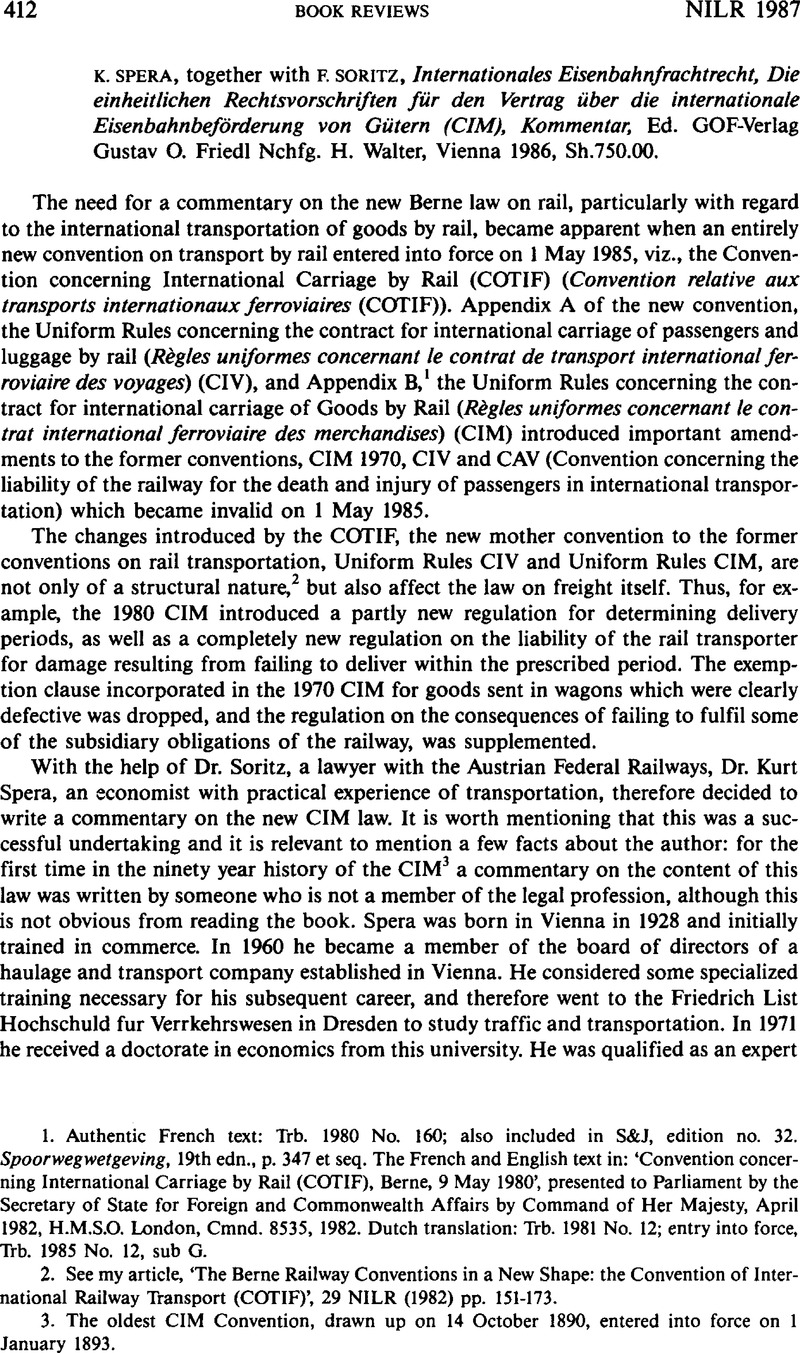No CrossRef data available.
Published online by Cambridge University Press: 21 May 2009

1. Authentic French text: Trb. 1980 No. 160; also included in S&J, edition no. 32. Spoorwegwetgeving, 19th edn., p. 347 et seq. The French and English text in: ‘Convention concerning International Carriage by Rail (COTIF), Berne, 9 May 1980’, presented to Parliament by the Secretary of State for Foreign and Commonwealth Affairs by Command of Her Majesty, April 1982, H.M.S.O. London, Cmnd. 8535, 1982. Dutch translation: Trb. 1981 No. 12; entry into force, Trb. 1985 No. 12, sub G.
2. See my article, ‘The Berne Railway Conventions in a New Shape: the Convention of International Railway Transport (COTIF)’, 29 NILR (1982) pp. 151–173.
3. The oldest CIM Convention, drawn up on 14 October 1890, entered into force on 1 January 1893.
4. In pursuance of Art. 8m para. 6 COTIF (previously Art. 69, para. 1 (b) CIM 1970) nongovernmental organizations are granted competence in the field of transport and are permitted to attend sessions of the review Conferences where they act in an advisory capacity. For IVT, see Actes de la VIIIe Conférence de revision CIM/CIV I, p. 518.
5. In pursuance of Art. 14, para. 1 COTIF, every member State may enter two of its subjects considered to be expert in the field of international transport as referees on the list kept at the Central Bureau for International Railway Transport in Berne (OCTI).
6. OCTI — Office Central des transports internationaux par chemins de fer. Originally established in Berne, the OCTI is now one of the organs of the OTIF (‘Organisation intergouvernmentale pour les transports internationaux ferroviaires’), the legal personality uniting the States participating in the Convention in accordance with Art. 1 COTIF. For the OCTI's area of competence, see Art. 9 COTIF.
7. The Additional Provisions issued by the railways to CIM 1980 on 1 January 1985 were drawn up, as they had been previously, by the Comité international des Transports par Chemins de fer (CIT) after mutual discussion, and are the same for all railways. They are therefore called ‘Disposition compl'mentaires uniformes’ (DCU), but have not yet achieved the status of a convention. The Dutch text is subject to ministerial approval in accordance with Art. 9, para. 2 CIM, and was announced in the Official Tariff notices of the Dutch Railways, no. 1880 of 28.1.1985 and is available from the registry of the Dutch railways in Utrecht. The CIT is an organ at the same level as the railways.
8. SMGS is an abbreviation with Russian initials for the ‘Agreement on international carriage of goods by rail’ of 1 November 1951 in the revised text of 1 July 1972, the agreement between the Ministries of railways of the Soviet Union, China and a number of East European and Asian countries which contains regulations of freight law for the carriage of goods by rail between these countries.
9. Authentic French text of the CIM, Appendices II, III and IV, respectively, in Trb. 1985 No. 12, pp. 382–388 (RIP), ibid., pp. 389–393 (RICo), and Trb. 1980 No. 160, pp. 104–105 (RIEx). Also see S&J, edition no. 32. Dutch translation of the RIEx in Trb. 1981 No. 211, pp. 106–107.
10. Authentic French text of CIM Appendix I (RID) in Trb. 1985 No. 12, pp. 6–381. The Dutch translation of the RID is included in Part I of the collection ‘Transport of Dangerous Substances’, ‘Transport of Dangerous Substances by Rail’, which is a State publication.
11. Nanassy, B. von, Das Internationale Eisenbahnfrachtrecht nach dem internationalen Uebereinkommen uber den Eisenbahngrachtverkehr vom. 25 Oktober 1952 (CIM), erlautert und kommentiert (1956)Google Scholar.
12. Nanassy, B. von and Wick, J., Das Internationale Eisenbahnfrachtrecht, gültig ab I Janner 1965, fur die Prakis kommentiert (1965)Google Scholar. Wick, J., Das Internationale Eisenbahnfrachtrecht nach der CIM, gültig ab 1 Janner 1975, fur die Prakis kommentiert (1974)Google Scholar.
13. The annual average value of the SDR in guilders was Dfl. 3.29 in 1984, Dfl. 3.36 in 1985, and Dfl. 2.87 in 1986. In January and February 1987 it was respectively Dfl. 2.62 and Dfl. 2.60. Source: Quarterly statements 1986/3 and 1986/4 of the Nederlandsche Bank, Statistical Appendix, p. 72.